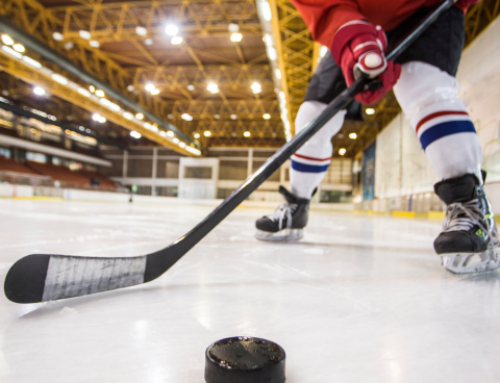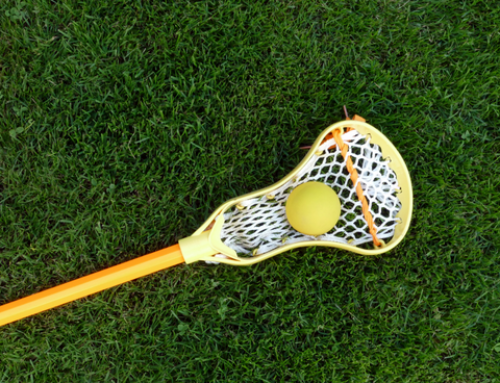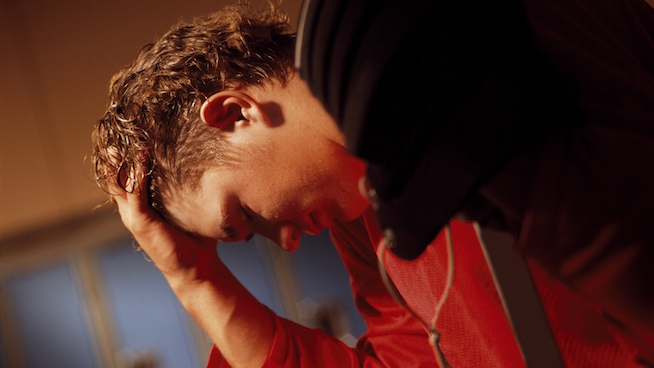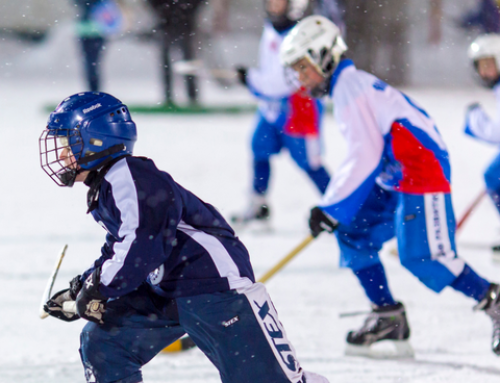How You Can Work To Prevent Common Hockey Injuries
Hockey season has finally arrived. Athletes are on the ice more often, as games will pick up, practices are a little more intense, and that’s not even mentioning all the off-ice conditioning. With the increase in hockey activities comes the increase in hockey-related injuries. Groin strains, hip flexor tightness, and other adductor injuries can be very common in the game of hockey.
Hockey Warm-Up
First, we will start with a warm-up. Whether a practice or a game, you need to warm up and get the blood flowing. It’s essential to warm up the muscles you will use for hockey. Hockey is different than most other team sports, mainly because it’s done on ice, with skates. It’s not sprinting or jumping. The movements are slightly different, which could be one of the reasons for the non-contact “hockey” injuries. The lateral motion and the constant flexion of the hip can raise the instance of hockey injuries because those motions are not regularly used in other sports, and therefore not properly trained for.
When I do warm-ups for any athlete training at my gym, I do warm-up exercises for the training session. A-skips, high knees, butt kicks, carioca, and side shuffles are some exercises that the athletes perform to prepare them for the session they are about to do. They raise the heart rate and prepare the body. Yes, it gets the heart rate up and gets the legs moving, but the warm-up doesn’t end there.
Dynamic Stretching and Mobility
Dynamic stretching and mobility exercises are essential tools to use when warming up and helping reduce injuries. The regular ones, such as knee-to-chest, the inchworm, and Frankenstein walks, can be considered staples to any warm-up, but when we talk about hockey, you might have a few other ones, such as the 90-90 hip flexor stretch. Because you are in the hip flexed state with skating, those two positions are vital to reduce hockey-related, non-contact injuries.
90-90 Position
The 90-90 position is used to warm up the hips for warming up. As the name suggests, put your hips and knees both at 90 degrees while seated. Keep your left foot in line with your right knee. With your hands on the ground, stretched out slightly behind you, and leaving your feet on the ground, raise your knees. Move them toward the other side of your body and move them back and forth for 45-60 seconds. This is a great exercise to help warm up and activate the hips.
Hip Flexor Dynamic Stretch
This one can be done walking or stationary. Start by taking a big step forward. Put your trailing knee on the ground and start to move your upper body forward, having your knee slowly move over your toes. Hold that position for about 5 seconds before taking a step and doing it with the other leg/hip flexors. Continue until you do 8-12 on each leg.
Side Lunge With Pause
If you have the space it can be done across the floor, but stationary is also fine. Step out to the right, bending your right and keeping your left leg straight. Your right foot should be flat on the ground. As your left leg straightens, point the toe towards the ceiling, rotate the foot, and keep your heel on the ground. Do 8-12 on each leg, pausing for 2-4 seconds each time.
Warming up the right muscles is a pretty easy way and just one of a couple of other ways to help prevent injuries in hockey. Another way is strength and conditioning. This might be an obvious one, but what might not be so obvious are the exercises you should be doing. Start to look at the motion you’re doing, the time you spend on the ice compared to the time you spend on the bench, as well as the muscles you are mostly using, and you should set yourself up in a good position.
When we’re talking about strength and conditioning for hockey, there are a few specific things you should consider. To reduce the likelihood of an injury, think of the way you move on the ice, how many minutes you actually play, and of those minutes, how much of that time you skate hard. I look at all that when I’m developing strength and conditioning programs for hockey players.
A lot of the traditional exercises are hard to get away from, such as bench press and back squats. There are so many more exercises that hockey players (and not just them) should do.
First, think in all planes of movement. You have the sagittal plane, or having the body divided in half from left to right. Then you have the frontal plane, or when the body is divided in half from front to back. Those two planes of motion are the most common in the weight room. Bench press, shoulder press, squats, deadlifts, and the list goes on. But, hockey, like other sports, involves motion in all three planes of movement. That’s right, I said THREE. We are forgetting about the transverse plane. That plane often gets neglected. Just think rotation, as the transverse plane divides the body from top to bottom. Not training in all three planes of motion, like a hockey player, is asking for injuries.
Strength Exercises For Hockey Players
- Wood-Chops
- Reverse Wood-Chops
- Stability Ball Plank
- Rear-Elevated Split Squat
- Single-Leg RDL
- TRX Push-ups
- TRX Single-Arm Rows
Strength has a lot to do for injury prevention in hockey players, as does the proper warm-up. These two things, though important, are not the only ways to reduce injuries. Proper movement patterns can add a huge benefit to on-ice performance and play a big role in injury reduction. The key is to move the right way in training to move the right way on the ice.
I do a lot of agility training for hockey players. There are a few movements that will be beneficial to them. Skating isn’t quite like running or sprinting. It’s usually the lateral motion of the legs that cause most injuries. Not only that but there is a lot of twisting, turning, backward motion. I incorporate all those in my training programs with hockey players. Here are a couple of staples in my hockey training programs that help reduce injuries because the correct movements are stressed:
Agility Training
Single-Leg Lateral Start to Sprint
- Start on one knee, facing perpendicular to the direction you’re sprinting
- With your inside knee is down, place your outside leg on a bit of an angle, with your knee pointing in the direction you’re going
- Start the sprint by pushing directly out, not up, and try to really extend your pushing leg, mimicking a skating stride
Backpedal to Forward Sprint
- Start by backpedaling in a straight direction
- Using a hip turn, open the hips to run forward in the same direction
- Make sure the hips turn enough so that the first leg clears space for the trailing knee to drive through and start your sprint
- Most hockey players know the Mohawk turn and you should be in that position for a split second (in a wider variation) when transitioning from backward to forwards, with the hip turn
There is a chance of injury in any sport you play, let alone one done on ice with the physical nature of hockey. You may never get rid of all injuries. Still, with training with a proper warm-up, correct strength exercises, and movement patterns, you can greatly decrease your chances of getting the typical most common injuries in hockey players. Just remember, hockey is different. Though sprinting and lifting weights will definitely help and are encouraged, start to train the movements that replicate skating and moves on the ice.
RECOMMENDED FOR YOU
MOST POPULAR
How You Can Work To Prevent Common Hockey Injuries
Hockey season has finally arrived. Athletes are on the ice more often, as games will pick up, practices are a little more intense, and that’s not even mentioning all the off-ice conditioning. With the increase in hockey activities comes the increase in hockey-related injuries. Groin strains, hip flexor tightness, and other adductor injuries can be very common in the game of hockey.
Hockey Warm-Up
First, we will start with a warm-up. Whether a practice or a game, you need to warm up and get the blood flowing. It’s essential to warm up the muscles you will use for hockey. Hockey is different than most other team sports, mainly because it’s done on ice, with skates. It’s not sprinting or jumping. The movements are slightly different, which could be one of the reasons for the non-contact “hockey” injuries. The lateral motion and the constant flexion of the hip can raise the instance of hockey injuries because those motions are not regularly used in other sports, and therefore not properly trained for.
When I do warm-ups for any athlete training at my gym, I do warm-up exercises for the training session. A-skips, high knees, butt kicks, carioca, and side shuffles are some exercises that the athletes perform to prepare them for the session they are about to do. They raise the heart rate and prepare the body. Yes, it gets the heart rate up and gets the legs moving, but the warm-up doesn’t end there.
Dynamic Stretching and Mobility
Dynamic stretching and mobility exercises are essential tools to use when warming up and helping reduce injuries. The regular ones, such as knee-to-chest, the inchworm, and Frankenstein walks, can be considered staples to any warm-up, but when we talk about hockey, you might have a few other ones, such as the 90-90 hip flexor stretch. Because you are in the hip flexed state with skating, those two positions are vital to reduce hockey-related, non-contact injuries.
90-90 Position
The 90-90 position is used to warm up the hips for warming up. As the name suggests, put your hips and knees both at 90 degrees while seated. Keep your left foot in line with your right knee. With your hands on the ground, stretched out slightly behind you, and leaving your feet on the ground, raise your knees. Move them toward the other side of your body and move them back and forth for 45-60 seconds. This is a great exercise to help warm up and activate the hips.
Hip Flexor Dynamic Stretch
This one can be done walking or stationary. Start by taking a big step forward. Put your trailing knee on the ground and start to move your upper body forward, having your knee slowly move over your toes. Hold that position for about 5 seconds before taking a step and doing it with the other leg/hip flexors. Continue until you do 8-12 on each leg.
Side Lunge With Pause
If you have the space it can be done across the floor, but stationary is also fine. Step out to the right, bending your right and keeping your left leg straight. Your right foot should be flat on the ground. As your left leg straightens, point the toe towards the ceiling, rotate the foot, and keep your heel on the ground. Do 8-12 on each leg, pausing for 2-4 seconds each time.
Warming up the right muscles is a pretty easy way and just one of a couple of other ways to help prevent injuries in hockey. Another way is strength and conditioning. This might be an obvious one, but what might not be so obvious are the exercises you should be doing. Start to look at the motion you’re doing, the time you spend on the ice compared to the time you spend on the bench, as well as the muscles you are mostly using, and you should set yourself up in a good position.
When we’re talking about strength and conditioning for hockey, there are a few specific things you should consider. To reduce the likelihood of an injury, think of the way you move on the ice, how many minutes you actually play, and of those minutes, how much of that time you skate hard. I look at all that when I’m developing strength and conditioning programs for hockey players.
A lot of the traditional exercises are hard to get away from, such as bench press and back squats. There are so many more exercises that hockey players (and not just them) should do.
First, think in all planes of movement. You have the sagittal plane, or having the body divided in half from left to right. Then you have the frontal plane, or when the body is divided in half from front to back. Those two planes of motion are the most common in the weight room. Bench press, shoulder press, squats, deadlifts, and the list goes on. But, hockey, like other sports, involves motion in all three planes of movement. That’s right, I said THREE. We are forgetting about the transverse plane. That plane often gets neglected. Just think rotation, as the transverse plane divides the body from top to bottom. Not training in all three planes of motion, like a hockey player, is asking for injuries.
Strength Exercises For Hockey Players
- Wood-Chops
- Reverse Wood-Chops
- Stability Ball Plank
- Rear-Elevated Split Squat
- Single-Leg RDL
- TRX Push-ups
- TRX Single-Arm Rows
Strength has a lot to do for injury prevention in hockey players, as does the proper warm-up. These two things, though important, are not the only ways to reduce injuries. Proper movement patterns can add a huge benefit to on-ice performance and play a big role in injury reduction. The key is to move the right way in training to move the right way on the ice.
I do a lot of agility training for hockey players. There are a few movements that will be beneficial to them. Skating isn’t quite like running or sprinting. It’s usually the lateral motion of the legs that cause most injuries. Not only that but there is a lot of twisting, turning, backward motion. I incorporate all those in my training programs with hockey players. Here are a couple of staples in my hockey training programs that help reduce injuries because the correct movements are stressed:
Agility Training
Single-Leg Lateral Start to Sprint
- Start on one knee, facing perpendicular to the direction you’re sprinting
- With your inside knee is down, place your outside leg on a bit of an angle, with your knee pointing in the direction you’re going
- Start the sprint by pushing directly out, not up, and try to really extend your pushing leg, mimicking a skating stride
Backpedal to Forward Sprint
- Start by backpedaling in a straight direction
- Using a hip turn, open the hips to run forward in the same direction
- Make sure the hips turn enough so that the first leg clears space for the trailing knee to drive through and start your sprint
- Most hockey players know the Mohawk turn and you should be in that position for a split second (in a wider variation) when transitioning from backward to forwards, with the hip turn
There is a chance of injury in any sport you play, let alone one done on ice with the physical nature of hockey. You may never get rid of all injuries. Still, with training with a proper warm-up, correct strength exercises, and movement patterns, you can greatly decrease your chances of getting the typical most common injuries in hockey players. Just remember, hockey is different. Though sprinting and lifting weights will definitely help and are encouraged, start to train the movements that replicate skating and moves on the ice.










